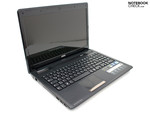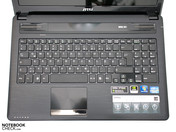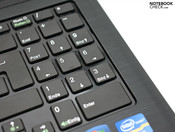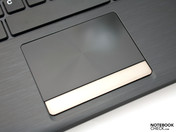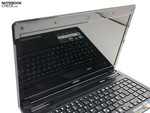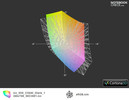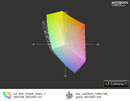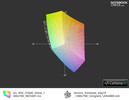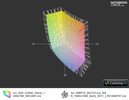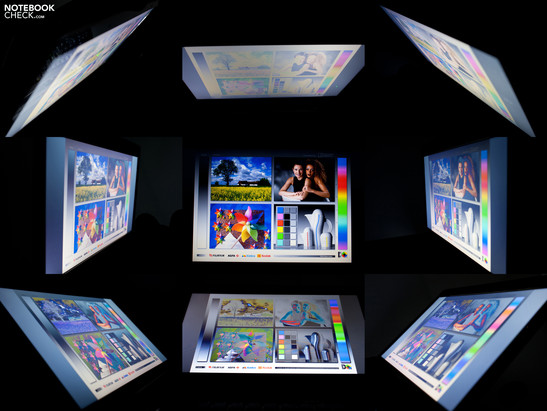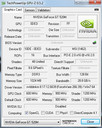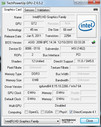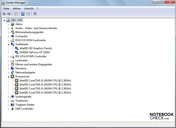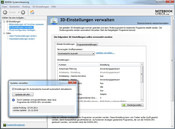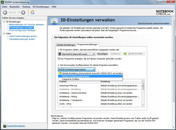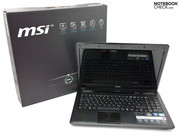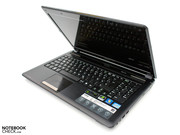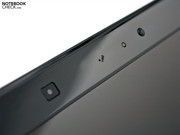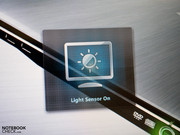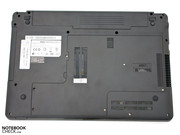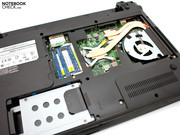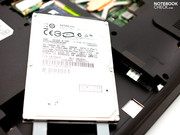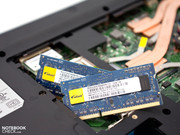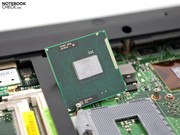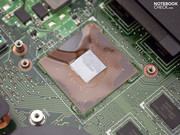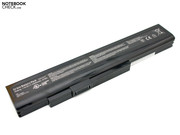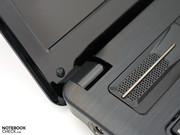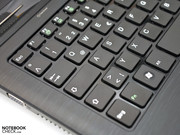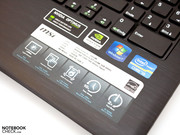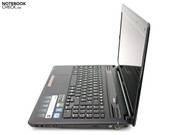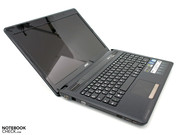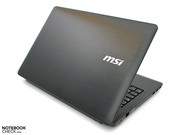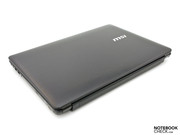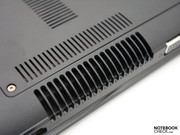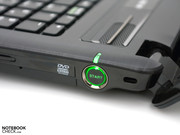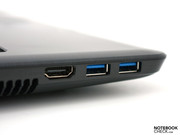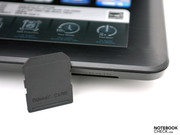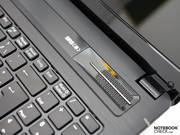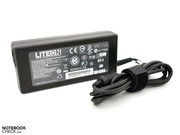Review MSI CX640 Notebook (GT 520M)

MSI presented its new C series machines to the public for the first time at CeBIT 2011. If you compare it to one of its predecessors, the MSI CX620MX, you will see that the whole series has had a design refresh. The case now has a black or silver finish all over, depending on your taste and choice of model. But as before there are two different branches of the series with four models in total for the German market. The CR640, for example, does not have its own graphics unit and so relies on the processor GPU - but it is also the cheapest.
The CX640 notebook reviewed here is offered in three different versions, which are fitted with the new Nvidia GeForce GT 520M mid-range graphics card as well as Nvidia Optimus, the automatic graphics switching system. The entry level CPU, as with the cheaper CR640 notebook, is a dual-core Intel Core i3-2310M processor with a speed of 2.1 GHz. The two next-fastest machines come equipped with an Intel Core i5-2410M and Intel Core i7-2630QM respectively. A glance at the rest of the specifications shows that for the CX series, the CPU is the only thing that changes along with the price.
The MSI CX640-i547W7P model which we tested is the happy medium that is supposed to appeal to the widest audience with its RRP of €649. A processor upgrade to an Intel Core i7 quad-core incurs a hefty additional cost of €150. Find out in our review whether MSI can succeed with this machine in the very competitive class of 15.6-inch multimedia notebooks.
Case
The MSI designers have been hard at work, and have come up with a new design. The case now features attractive matt surfaces, imprinted with an aluminium-style finish. The inside surfaces shine with a high-gloss finish, which looks classy but is not as hard-wearing. This is a particular problem in the area around the ports, where the first scratches appeared after a short period of use. For a consumer-orientated notebook, however, the glossy surfaces are justified, because end-users seem to place a lot of importance on looks. The workmanship of the plastic looks good overall, and the surfaces also have a pleasant feel to them.
Our first criticism is that the case is only moderately robust. The ergonomically important regions around the keyboard and touchpad, as well as the notebook’s underbelly, flex noticeably when pressure is applied. The laptop ought to stand firm around the input devices at least. The lid is also easy to flex; localized pressure produces distortions on the screen. The lid’s hinges hold it firmly in place, but they do not cope well with the weight of the screen when it is moved beyond the normal viewing position. Another small criticism is that the lid wobbles slightly after being moved.
The notebook’s dimensions of 380 x 260 x 27.1 - 34.0 mm (l x w x h) and its total weight of 2.54 kg (including the battery) are average for a machine with this size screen. A good thing about MSI is their experience in manufacturing barebone notebooks, which generally have a large access panel. In this case, the RAM, hard drive and even the CPU can be swapped out via the underside of the notebook. However, it should be noted that there is a sticker on the CPU cooling unit warning that this could invalidate the warranty. As for RAM, the maximum you can install is 8 GB. In a short operational test, we found that 8 GB (2x 4 GB) with a speed of 1066 MHz made by Kingston (model: KVR1066D3S7/4G) were recognized and could be used without any issues, with the same being true of two 4 GB bars, each with 1333 MHz, made by OCZ (model: OCZ3M13334G).
Connectivity
The sides of the notebook are not lacking in anything; as well as the usual suspects, like two USB 2.0 ports, a VGA output port, and the audio ports, the notebook also comes with a modern HDMI port, a 7-in-1 card reader and two USB 3.0 ports. For the optical drive, MSI has gone for a DVD Super Multi Burner made by Pioneer (model: DVRTD10RS) and not included an optional Blu-ray drive. The layout of the ports places many of them towards the front of the notebook, which may get slightly awkward for the user. But aside from this lack of finesse, there is nothing to complain about in the range of ports.
Communication
The notebook is equipped with the latest essential hardware for communication, but without any extras. Gigabit Ethernet is supported via an Atheros AR8151 controller, as well as 802.11n WLAN (Atheros AR9285). Additional wireless technologies such as Bluetooth 3.0 +HS or an integrated UMTS module have not been included. However, you could add on these functions using external USB dongles.
Accessories
Other than the machine itself, the box contains only the most essential accessories. This includes the six-cell battery, the mains adaptor and power cable, as well as some handbooks and a software and driver DVD. We did not expect any more from a notebook in this price range. Additional accessories can be purchased separately. MSI has also avoided the expensive full versions of various programs. Along with the Microsoft Windows 7 Home Premium operating system (64 Bit), you get various pieces of freeware, a trial version of Norton’s anti-virus software, and the Starter version of Office 2010. You should remove as many unnecessary programs as possible.
Warranty
MSI does not lag behind in this area, offering a 24-month warranty including Collect & Return. Many other manufacturers offer only 12-month warranties where you are responsible for sending off the defective machine yourself. MSI also offers the option of extending the warranty from 24 to 36 months. The RRP for this upgrade is €139.
Input Devices
Keyboard
The keyboard has benefited from the case redesign. At first glance we appear to have a generously sized keyboard with free-standing keys (chiclet-style) and a separate number pad. MSI has learnt from past mistakes and included a large right-hand Shift key and a normal-sized Enter key, to reduce typing errors. However, the typing feel itself has not changed, and is still unconvincing in our opinion. The tactile feedback is not clear and the travel is very short. The overall feel when typing is rather spongy.
The layout of the keys is not ideal for gamers. The arrow keys are squeezed into a tiny space below the other keys, and the important WASD triangle of keys is slightly askew. The number block also seems squashed and is not laid out in the usual way, a change from the predecessor machine, the MSI CX620MX. One positive point is the clear lettering on the keys. The Fn functions are also marked clearly using green symbols.
Touchpad
The touchpad suffers from the poor robustness that was mentioned earlier. But apart from that, the feel of the touchpad is convincing, with its slightly roughened surface which is different to the palm rest. Modern multi-touch gestures make for easier use. A horizontal scroll bar is also included as well as a vertical one, but these are not marked. The touchpad buttons are covered by a single bar with a smart chrome look. From an ergonomic perspective, two separate buttons would be preferable. For this reason and because of their spongy feedback, we would recommend the use of an external mouse.
Display
All models of the MSI CX640 come with a 15.6-inch screen, which is fairly typical for a mainstream notebook. The native resolution of 1366 x 768 pixels is also normal these days. MSI does not offer any options regarding the screen, so you have to be satisfied with the glossy surface. Higher resolutions are supported using an external screen via the analogue video output (VGA) or the more modern HDMI output. The picture quality at a resolution of 1920 x 1080 (Full HD, 1080p) was convincing when we tested both of these methods.
The integrated brightness sensor is a nice feature. Situated above the screen and to the right, it chooses the most appropriate brightness depending on your surroundings. This automatic adjustment works well, thanks to its fine gradation with 15 steps. The sensor is easily activated or deactivated using an Fn combination (Fn + F4).
The panel (model SEC3651) has LED backlighting and is manufactured by Seiko Epson. We examined it with our Gossen Mavo-Monitor and found it to be of average quality. The maximum screen brightness of 261 cd/m², as well as the average brightness of 238 cd/m², are good results which fall within the expected range for this configuration. We did measure an uneven distribution of brightness across the surface. The brightness decreases as you move from the bottom of the screen to the top, resulting in a uniformity of only 84%. However, this difference is not apparent during everyday use of the notebook.
| |||||||||||||||||||||||||
Brightness Distribution: 84 %
Center on Battery: 248 cd/m²
Contrast: 151:1 (Black: 1.64 cd/m²)
54.5% AdobeRGB 1998 (Argyll 3D)
74% sRGB (Argyll 3D)
53% Display P3 (Argyll 3D)
The black level, and the contrast that results from it, also shows room for improvement. Our measurement of 1.95 cd/m² shows that the screen cannot display a deep black colour, and as a result the contrast ratio (134:1) is very low. However, the colour reproduction and picture definition appear better than this to the naked eye, probably because of the glossy screen finish.
Like most consumer laptops in the sub-€1,000 price bracket, this MSI notebook is not suitable for professional image editing work. The comparison (below) of colour spaces shows that it is not even close to covering the standard sRGB colour space. But compared to the previous model, the coverage has improved.
This combination of average brightness readings and a glossy finish mean that the screen is not suitable for outdoor use. Working outside in the shade is possible in certain conditions, as the screen brightness counteracts the reflections in part. But direct sunlight makes it impossible to work, especially with the reflections from the glossy screen bezel too. Comparable entry-level notebooks with a matt screen have a clear advantage here, like the Schenker Xesia E510 Entry for example.
The viewing angles hold no surprises; they are what you would expect from a bog-standard panel. Horizontally, the image is stable up until around 145 degrees, with no distortions. Vertically, the colours quickly invert and the screen turns whiter as you close the lid.
Performance
There are three modern Intel processors to choose from. The Intel Core i5-2410M that we tested is the middle one, with 624 million transistors, 3 MB of L3 cache and a decent base speed of 2.3 GHz. With its integrated Turbo Boost 2.0 technology, the processor is overclocked to a maximum of 2.9 GHz when required and can be downclocked too. Those wanting a cheaper machine might want to look at the smaller model with Intel Core i3-2310M (2.1 GHz, 3 MB L3 cache), which does without Turbo Boost. The larger model with a quad-core Intel Core i7-2630QM (2 GHz, 6 MB L3 cache) will probably not feel noticeably different during everyday use. This upgrade also costs around €150 extra.
Hyper-threading technology is a useful function that was already used in processors prior to this generation. It gives you two virtual cores to accompany the two physical ones. This means that dual-core systems actually have four threads while quad-core systems have eight. The Intel Core i5-2410M is made using the 32 nm process, like other Sandy Bridge CPUs, and houses the GMA HD 3000 graphics unit. This GPU is not suitable for gaming, but it is the perfect option for Nvidia’s automatic graphics switching, for good office and multimedia performance and for a longer battery life.
Nvidia: Alongside the graphics unit integrated into the processor, MSI have included the new Nvidia GeForce GT 520M to handle simple games. It is a basic mid-range chip with 1 GB of DDR3 video memory; technologically it is inferior to the GeForce GT 525M and the GT 540M. The latter, for example, proved its gaming capabilities in our review of the Dell XPS 15. Unlike the Intel GMA HD 3000, the Nvidia GPU supports DirectX 11 and Shader Model 5.0. However, in our comparisons database of GPUs the two systems are close together and the difference between them does not seem that big.
Interestingly, Nvidia offers two varieties of the GT 520M. The chip we are testing here is the N12P-GV2-A1 model with 128 Bit memory bus, based on the GF108 chip. The faster GT 540M is also based on this. But compared to the other version based on the GF119 (740 MHz core speed, 64 Bit memory bandwidth), the version in our CX640 has a core speed of only 600 MHz (1200 MHz shader speed). It will have to be seen in a future review whether there is any difference in performance.
To achieve a perfect symbiosis between the two graphics units, MSI has employed the Nvidia Optimus automatic graphics switching system. This selects the most appropriate GPU to use, based on predetermined settings or current system demands. With Nvidia’s latest ForceWare drivers the switching process is generally very reliable, but evidently not perfect. In our review model the dedicated Nvidia GPU temporarily vanished from the system, and only after a trip to BIOS (F2) and a fresh installation of the 266.39 driver was it ready to work again.
CPU performance
The first reviews have already shown that Intel’s new Sandy Bridge processors offer a considerable advance in performance for a good price. The Intel Core i5-2410M demonstrates this improved performance in the CineBench R10 and R11.5 benchmarks for example.
In the multi-thread rendering (64 Bit) Cinebench R10 benchmark, the CPU scores 9,653 points, placing it in the top third of our database. The MSI CX640 can claim substantially better performance compared to similarly equipped notebooks. The dual-core Intel Core i5-450M, previously a very common choice, trails by about 15% with 8,229 points (Samsung R590). In the single-thread rendering test the different is even somewhat bigger, at 19% (4,502 to 3,625 points). However, the Intel Core i7-2630QM, one of the options for the MSI CX640, is clearly ahead when tested in the Schenker XMG A501; in the multi-thread rendering the CPU’s eight threads help it to 15,297 points (+37%). But, in the single-thread calculation the difference is only very slight (4,569 to 4,502 points).
The latest Cinebench R11.5 benchmark by Maxon provides a similar result. The Intel Core i5-2410M finishes ahead of the Intel Core i5-450M, with 2.58 points to 2.2. The difference in this test is a good 15.2 %. The Intel Core i7-2630QM is a long way ahead of the Intel Core i5 once again, with 4.4 points (50% difference). However, during everyday use this difference in performance will not seem so pronounced.
System performance
The next benchmark is the PCMark Vantage (64 Bit) from Futuremark. It evaluates the system as a whole, not just the CPU. The MSI CX640 scores 6,019 points, placing it again in the top third. The Samsung R590 lies 14.4% behind with only 5,148 points. The Schenker XMG A501 with the quad-core CPU is faster and secures itself a lead of around 53% (13,103 points). However, this can be attributed to the SSD that is used in this system. Subjectively the CX640-i547W7P’s system performance feels good, with short load times and windows that are quick to appear.
| PCMark Vantage Result | 6019 points | |
Help | ||
GPU performance
Before we look at pure gaming performance, we will take a look at the Futuremark 3DMark tests. With the GeForce GT 520M activated, our Taiwanese notebook achieved 4,572 points in the 3DMark 06 benchmark, which gives a solid basis for comparisons. The difference compared to the Intel GMA HD 3000 is relatively small, at only 11.2% (4,572 to 4,061 points). The Schenker XMG A501 with GT 540M performs 39.5% better (7,558 points to 4,572).
A comparison using the latest 3DMark 11 is essential when you have a DirectX 11 GPU. Our notebook gets an overall score of only 518 points in this test, placing it near the bottom of our database. Only the new AMD APUs score worse than this (C-50, E-350). The AMD Radeon HD 6470M or the GeForce GT 540M are in a different league, with a difference of 18.6% (Sony VAIO VPC-CA1S1E) and 47.6% (Dell XPS 15) respectively.
| 3DMark 2001SE Standard | 24651 points | |
| 3DMark 03 Standard | 13147 points | |
| 3DMark 05 Standard | 8461 points | |
| 3DMark 06 Standard Score | 4572 points | |
| 3DMark Vantage P Result | 1513 points | |
| 3DMark 11 Performance | 518 points | |
Help | ||
HDD performance
MSI is using a 500 GB Hitachi hard drive in all its CX series machines. It is a Travelstar 5K500 (HTS545050B9A300) model which operates at 5,400 rpm. The hard drive benchmarks HD Tune Pro 4.6 and CrystalDiskMark calculate maximum transfer rates (reading) of between 86.3 and 87.5 MB/s. Combined with an access time of 18.6 milliseconds this gives it average performance overall. For a noticeably faster experience it is worth upgrading to a modern solid state drive. Thanks to SATA 3 support (6 Gbit/s), the very latest drives can be used. Examples would be the Intels SSD 510 (Elmcrest) series or the even faster OCZ Vertex 3.
Gaming verdict
The Nvidia GeForce GT 520M is intended as a basic mid-range GPU, suitable for simple, undemanding games. The chip is supported by 1 GB of independent DDR3 RAM. Looking at a selection of games from the past few years, you can see that the slightly older games will run smoothly on the lowest or sometimes medium settings. As soon as you hit more recent, graphics-intensive games, like Battlefield: Bad Company 2 or Mafia II, you run into difficulties. They may run reasonably smoothly on the minimum settings, but it would not be an enjoyable experience because, like all the other games, they are only fun at a decent screen resolution and with high details settings.
The raw numbers are interesting as a basis for comparison. The frame rate for Battlefield: Bad Company 2 with the Nvidia GeForce GT 520M was 30 fps. If you deactivate this GPU and use the integrated GMA HD 3000 instead, on the same settings, you get a better result (34 fps). We took several readings but this did not change. But with games like Mafia II or StarCraft II the dedicated GPU does do better than the integrated unit. On minimum settings the GT 520M offers a 32.6% improvement (34 fps to 23 fps) and 47.9% improvement (144 fps to 75 fps), respectively.
As these frame rates do not represent sophisticated gaming performance, the discerning customer may want to have a look at the faster Nvidia GeForce GT 540M. The Packard Bell EasyNote TS11 (Intel Core i7-2630QM) can reach 41.4 fps for StarCraft II on the medium settings. This is a difference of 39.6% (GT 520M: 25 fps). A Mafia II comparison with the Sony VAIO VPC-F21Z1E/BI delivers similar results; the difference on the medium settings for this game is around 40%.
| low | med. | high | ultra | |
|---|---|---|---|---|
| Counter-Strike Source (2004) | 189 | 134 | ||
| World of Warcraft (2005) | 199 | 69 | 19 | |
| Half Life 2 - Lost Coast Benchmark (2005) | 138 | |||
| Call of Juarez Benchmark (2006) | 18 | |||
| World in Conflict - Benchmark (2007) | 154 | 41 | 25 | 8 |
| Crysis - GPU Benchmark (2007) | 65 | 26 | 16 | 4 |
| Crysis - CPU Benchmark (2007) | 59 | 25 | 15 | 4 |
| Trackmania Nations Forever (2008) | 245 | 44 | 15 | |
| Left 4 Dead (2008) | 119 | 46 | ||
| Battlefield: Bad Company 2 (2010) | 30 | 22 | 16 | 8 |
| StarCraft 2 (2010) | 144 | 25 | 19 | 10 |
| Mafia 2 (2010) | 34 | 26 | 22 | 13 |
| Crysis 2 (2011) | 33 | 21 | 16 | 5 |
Emissions
System noise
Under the hood of the CX640, the cooling system has been adapted to suit the new hardware. It is still a small fan that is responsible for the noise, as well as the hard drive. When idle, the notebook remains unobtrusive at a constant 31.1 dB(A). However, the Hitachi hard drive does attract attention with its soft clatter. The 33.6 dB(A) that we measured is loud enough to drown out the fan in the left-hand part of the case.
With heavy use, the noise level increases, as you would expect. At its maximum of 43.2 dB(A) the CX640 is clearly audible, with the fan remaining at a constant high speed.
Noise level
| Idle |
| 31.3 / 31.3 / 31.3 dB(A) |
| HDD |
| 33.6 dB(A) |
| DVD |
| 35.3 / dB(A) |
| Load |
| 35.3 / 43.2 dB(A) |
 | ||
30 dB silent 40 dB(A) audible 50 dB(A) loud |
||
min: | ||
Temperature
It is clear from the case temperature readings that the cooling system has been improved. The previous model had serious problems when in idle. The new generation makes a much better job of it, with a maximum of only 27.3 degrees Celsius when idle, on the top side of the case. Every segment of the laptop is shaded blue (problem-free) in our graphic below.
With heavy use, the waste heat increases and so do the temperature readings on the case. The maximum is 36.7 degrees Celsius, again in the area of the keyboard, and not underneath the laptop as you might expect. Fortunately this doesn’t interfere with your use of the keyboard as the keys themselves remain cool. Inside the laptop, the processor approaches the limits of what is acceptable, hitting a maximum temperature of around 100 degrees Celsius. It is slightly concerning to think of the i7-2630QM CPU, one of the other options for this machine, with its TDP of 45 W and higher cooling requirement.
(+) The maximum temperature on the upper side is 36.7 °C / 98 F, compared to the average of 36.9 °C / 98 F, ranging from 21.1 to 71 °C for the class Multimedia.
(+) The bottom heats up to a maximum of 35.1 °C / 95 F, compared to the average of 39.2 °C / 103 F
(+) In idle usage, the average temperature for the upper side is 24.9 °C / 77 F, compared to the device average of 31.3 °C / 88 F.
(+) The palmrests and touchpad are cooler than skin temperature with a maximum of 30.9 °C / 87.6 F and are therefore cool to the touch.
(-) The average temperature of the palmrest area of similar devices was 28.7 °C / 83.7 F (-2.2 °C / -3.9 F).
Speakers
MSI is marketing the CX640 as a multimedia notebook with SRS Premium Sound. Accordingly there are two stereo speakers above the keyboard along with the relevant logo. Visually they make the right impression; but the sound quality is almost obscenely bad. The poor maximum volume and the overpowering high tones make music sound tinny, and bass and low tones are just not there. A multimedia laptop should at least have reasonably balanced sound, particularly if you’re calling it ‘Premium Sound’.
However, you can hook up a high-quality set of speakers, headphones, or your own home cinema system using the notebook’s HDMI port or the 3.5 mm stereo output. The sound quality using this method seemed to be good, with no noise or crackling during our testing.
Battery life
Another advantage of the Intel Sandy Bridge CPUs is their low energy consumption despite their better performance. The Intel Core i5-2410M including GMA HD 3000 graphics has a specified thermal design power (TDP) of 35 Watts. The dedicated Nvidia GeForce GT 520M needs at most an additional 17 Watts (TDP), though this number should be a little lower in our review model, because the GPU is only running with a core speed of 600 MHz instead of 740 MHz.
The automatic graphics switching system, Nvidia Optimus, is a definite plus when it comes to energy consumption. With light use and the Nvidia GPU deactivated, the energy use is minimal, which extends the battery life. In idle this gives a very low consumption of between 7.6 and 11.9 Watts. With heavy use, the Nvidia GT 520M kicks in, and the processor is also called upon to work at a higher speed. The result is a big difference compared to the idle figures, with a maximum consumption of 77.3 Watts.
The six-cell lithium-ion battery (included) should be able to handle this level of energy consumption during mobile use. It has the usual capacity of 47 Wh and 4400 mAh. It sits flush with the back part of the machine, which is a good thing. MSI do not offer an optional high-performance battery, but you can buy a replacement or second six-cell battery for €89 (RRP).
| Off / Standby | |
| Idle | |
| Load |
|
Key:
min: | |
'You can coax the longest possible battery life from the six-cell battery using the lowest screen brightness and maximum energy saving settings. This is the result that the Reader’s Test by Battery Eater provides. Starting with a fully charged battery, it was 7 hours and 11 minutes before it was all used up and we had to resort to mains power again. The CX640 also puts in a respectable performance when it comes to playing a DVD or surfing the web via WLAN. With results of 283 and 302 minutes respectively, you will have more than enough time. On the other hand, comparable machines that come with a high-performance battery, like the latest Dell XPS 15, have the upper hand here.
The Battery Eater Classic Test determines the minimum anticipated battery life using stress on the hardware, maximum screen brightness (the brightness sensor was turned off for all tests) and an activated WLAN adaptor. During this test the dedicated Nvidia GeForce GT 520M was of course active too. After no more than 94 minutes (1 hour 34 minutes) your time away from the plug socket is up.
Verdict
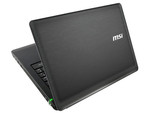
Our final summary of the MSI CX640-i547W7P contains some good and some not so good points. We like the new design of the series, and the updated specs and range of ports are also moderately impressive. Demanding users will be less impressed by the not wholly robust case and the spongy input devices, however. The miserable speakers are also out of place; we expected more from a multimedia notebook. The only thing that can partially excuse MSI on this front is the laptop’s price of around €600.
The factory warranty of 24 months and the integrated brightness sensor are nice additions from Taiwan. The good performance of the Intel Core i5-2410M and the new Nvidia GeForce GT 520M is another bonus, although the throttling of the dedicated graphics unit stands out. The 15.6-inch glossy screen is not exactly the best either; it is merely average.
The battery life and energy consumption are convincing; the laptop can last for an average of five hours away from a wall socket. To conclude: a nice machine with many strengths, but also some weaknesses that should have been caught during the development process.




